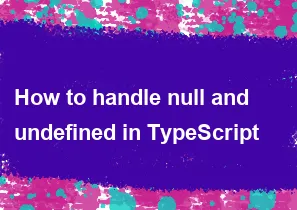How to handle null and undefined in TypeScript

In TypeScript, handling null and undefined involves using type annotations and possibly additional checks to ensure that your code is robust and can handle these values appropriately. TypeScript provides several mechanisms to work with null and undefined. Here are some common techniques:
Using Union Types: You can use union types to allow a variable to be of multiple types, including
nullorundefined.typescriptlet variable: string | null = null;This means that
variablecan be either a string ornull. You can use conditional checks to handle different scenarios:typescriptif (variable !== null) { // Handle non-null case console.log(variable.length); } else { // Handle null case console.log("Variable is null"); }Using the Non-null Assertion Operator (
!): The non-null assertion operator (!) tells TypeScript to treat a value as non-null, even if the type system can't guarantee it. Use this cautiously, as it may lead to runtime errors if misused.typescriptlet variable: string | null = getNullableString(); console.log(variable!.length); // Using ! to assert non-nullConfiguring
strictNullChecks: TypeScript has a compiler option calledstrictNullCheckswhich, when enabled, makes the type system more strict about handlingnullandundefined. IfstrictNullChecksis on, you need to explicitly check fornullandundefinedin certain situations.To enable
strictNullChecks, add the following to yourtsconfig.json:json{ "compilerOptions": { "strictNullChecks": true } }Optional Chaining and Nullish Coalescing: TypeScript 3.7 introduced optional chaining (
?.) and nullish coalescing (??) operators, which help simplify code dealing with potentiallynullorundefinedvalues.typescriptlet name: string | undefined = getUser()?.name; let defaultValue: string = someValue ?? "default";Optional chaining allows you to safely access nested properties without explicitly checking for null or undefined, while nullish coalescing provides a concise way to handle default values when a variable is null or undefined.
Remember to adapt your approach based on the specific needs and constraints of your code. It's crucial to have a good understanding of the potential sources of null and undefined in your code and handle them appropriately.
-
Popular Post
- How to optimize for Google's About This Result feature for local businesses
- How to implement multi-language support in an Express.js application
- How to handle and optimize for changes in mobile search behavior
- How to handle CORS in a Node.js application
- How to use Vue.js with a UI framework (e.g., Vuetify, Element UI)
- How to configure Laravel Telescope for monitoring and profiling API requests
- How to create a command-line tool using the Commander.js library in Node.js
- How to implement code splitting in a React.js application
- How to use the AWS SDK for Node.js to interact with various AWS services
- How to use the Node.js Stream API for efficient data processing
- How to implement a cookie parser middleware in Node.js
- How to implement WebSockets for real-time communication in React
-
Latest Post
- How to implement a dynamic form with dynamic field styling based on user input in Next.js
- How to create a custom hook for handling user interactions with the browser's device motion in Next.js
- How to create a custom hook for handling user interactions with the browser's battery status in Next.js
- How to implement a dynamic form with dynamic field visibility based on user input in Next.js
- How to implement a dynamic form with real-time collaboration features in Next.js
- How to create a custom hook for handling user interactions with the browser's media devices in Next.js
- How to use the useSWRInfinite hook for paginating data with a custom loading indicator in Next.js
- How to create a custom hook for handling user interactions with the browser's network status in Next.js
- How to create a custom hook for handling user interactions with the browser's location in Next.js
- How to implement a dynamic form with multi-language support in Next.js
- How to create a custom hook for handling user interactions with the browser's ambient light sensor in Next.js
- How to use the useHover hook for creating interactive image zoom effects in Next.js